Health Policy- Medicare part D
VerifiedAdded on 2023/02/01
|11
|3066
|44
AI Summary
This essay elaborates on the Medicare policy part D, its implementation, stakeholders involved, and tools/strategies used during its enforcement.
Contribute Materials
Your contribution can guide someone’s learning journey. Share your
documents today.
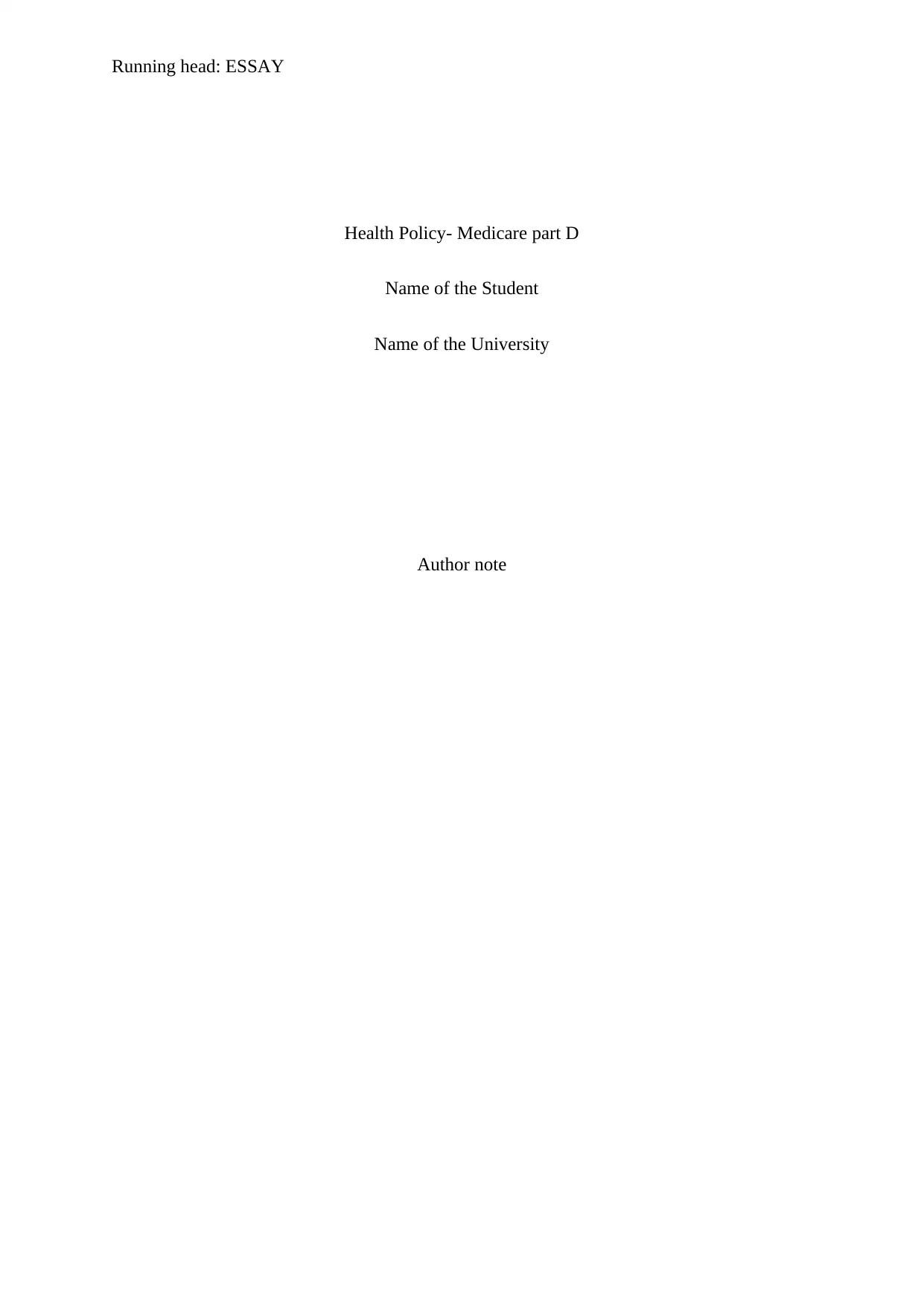
Running head: ESSAY
Health Policy- Medicare part D
Name of the Student
Name of the University
Author note
Health Policy- Medicare part D
Name of the Student
Name of the University
Author note
Secure Best Marks with AI Grader
Need help grading? Try our AI Grader for instant feedback on your assignments.

1ESSAY
Introduction
Healthcare policies encompass plans, decisions and actions that are primarily
undertaken with the aim of accomplishing particular healthcare goals and objectives within a
community. An unambiguous health policy is formulated with the aim of defining a clear
visualization for the future, which in turn would facilitate the establishment of specific targets
for the enhancement of health and wellbeing of the society (Gauld et al., 2014). In other
words, healthcare policies have also been found to outline the significances and the
anticipated responsibilities of dissimilar groups, besides creating a consensus and informing
people. Several categories of healthcare policies include There are many categories of health
policies, including pharmaceutical policy, personal healthcare policy, and those allied to
public health services such as, tobacco control, vaccination, or policies for promoting
breastfeeding. This essay will elaborate on the Medicare policy part D and will further
illustrate the reason behind its implementation, the stakeholders involved, and tools or
strategies used during its enforcement.
Medicare part D
Also referred to as the Medicare prescription drug benefit, Medicare part D is an
optional federal government program of the United States that has been formulated with the
aim of providing assistance to Medicare beneficiaries for paying self-administered drugs that
have been prescribed, by creating provisions for drug insurance premiums (Kirchhoff, 2018).
This policy was proposed in 2003 by the then president George Bush, following which it
became a component of the Medicare Modernization Act (Kennedy & Wood, 2016). In other
words, some key attributes of this policy can be accredited to the fact that the policy provides
the opportunity of basic choices to all Medicare recipients that encompass namely, their
presence in old-style Medicare without the need for signing up for the medicine drug benefit,
as sketched in the Act, enrolment in Medicare drug plans, enrolment in other all-inclusive
Introduction
Healthcare policies encompass plans, decisions and actions that are primarily
undertaken with the aim of accomplishing particular healthcare goals and objectives within a
community. An unambiguous health policy is formulated with the aim of defining a clear
visualization for the future, which in turn would facilitate the establishment of specific targets
for the enhancement of health and wellbeing of the society (Gauld et al., 2014). In other
words, healthcare policies have also been found to outline the significances and the
anticipated responsibilities of dissimilar groups, besides creating a consensus and informing
people. Several categories of healthcare policies include There are many categories of health
policies, including pharmaceutical policy, personal healthcare policy, and those allied to
public health services such as, tobacco control, vaccination, or policies for promoting
breastfeeding. This essay will elaborate on the Medicare policy part D and will further
illustrate the reason behind its implementation, the stakeholders involved, and tools or
strategies used during its enforcement.
Medicare part D
Also referred to as the Medicare prescription drug benefit, Medicare part D is an
optional federal government program of the United States that has been formulated with the
aim of providing assistance to Medicare beneficiaries for paying self-administered drugs that
have been prescribed, by creating provisions for drug insurance premiums (Kirchhoff, 2018).
This policy was proposed in 2003 by the then president George Bush, following which it
became a component of the Medicare Modernization Act (Kennedy & Wood, 2016). In other
words, some key attributes of this policy can be accredited to the fact that the policy provides
the opportunity of basic choices to all Medicare recipients that encompass namely, their
presence in old-style Medicare without the need for signing up for the medicine drug benefit,
as sketched in the Act, enrolment in Medicare drug plans, enrolment in other all-inclusive
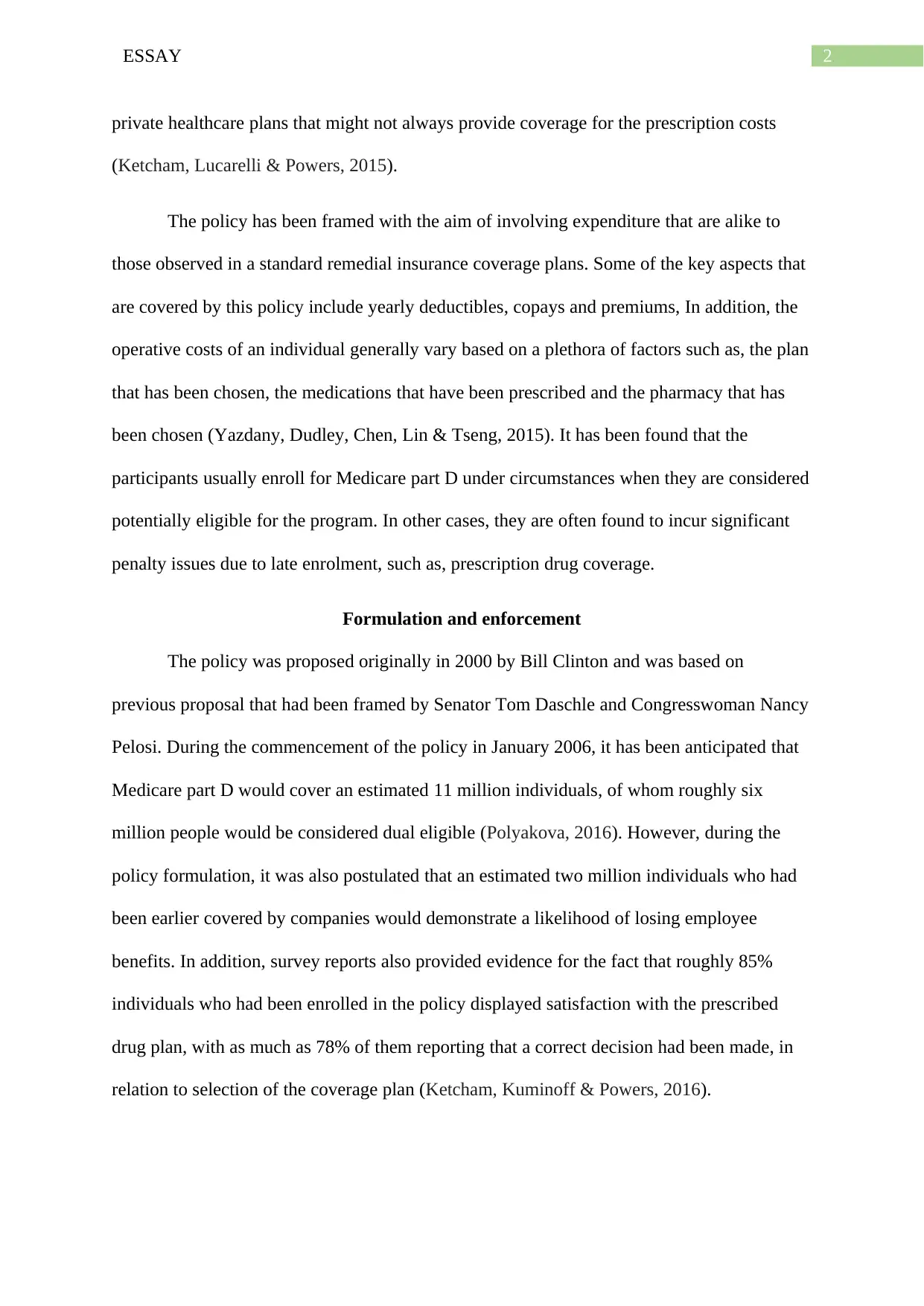
2ESSAY
private healthcare plans that might not always provide coverage for the prescription costs
(Ketcham, Lucarelli & Powers, 2015).
The policy has been framed with the aim of involving expenditure that are alike to
those observed in a standard remedial insurance coverage plans. Some of the key aspects that
are covered by this policy include yearly deductibles, copays and premiums, In addition, the
operative costs of an individual generally vary based on a plethora of factors such as, the plan
that has been chosen, the medications that have been prescribed and the pharmacy that has
been chosen (Yazdany, Dudley, Chen, Lin & Tseng, 2015). It has been found that the
participants usually enroll for Medicare part D under circumstances when they are considered
potentially eligible for the program. In other cases, they are often found to incur significant
penalty issues due to late enrolment, such as, prescription drug coverage.
Formulation and enforcement
The policy was proposed originally in 2000 by Bill Clinton and was based on
previous proposal that had been framed by Senator Tom Daschle and Congresswoman Nancy
Pelosi. During the commencement of the policy in January 2006, it has been anticipated that
Medicare part D would cover an estimated 11 million individuals, of whom roughly six
million people would be considered dual eligible (Polyakova, 2016). However, during the
policy formulation, it was also postulated that an estimated two million individuals who had
been earlier covered by companies would demonstrate a likelihood of losing employee
benefits. In addition, survey reports also provided evidence for the fact that roughly 85%
individuals who had been enrolled in the policy displayed satisfaction with the prescribed
drug plan, with as much as 78% of them reporting that a correct decision had been made, in
relation to selection of the coverage plan (Ketcham, Kuminoff & Powers, 2016).
private healthcare plans that might not always provide coverage for the prescription costs
(Ketcham, Lucarelli & Powers, 2015).
The policy has been framed with the aim of involving expenditure that are alike to
those observed in a standard remedial insurance coverage plans. Some of the key aspects that
are covered by this policy include yearly deductibles, copays and premiums, In addition, the
operative costs of an individual generally vary based on a plethora of factors such as, the plan
that has been chosen, the medications that have been prescribed and the pharmacy that has
been chosen (Yazdany, Dudley, Chen, Lin & Tseng, 2015). It has been found that the
participants usually enroll for Medicare part D under circumstances when they are considered
potentially eligible for the program. In other cases, they are often found to incur significant
penalty issues due to late enrolment, such as, prescription drug coverage.
Formulation and enforcement
The policy was proposed originally in 2000 by Bill Clinton and was based on
previous proposal that had been framed by Senator Tom Daschle and Congresswoman Nancy
Pelosi. During the commencement of the policy in January 2006, it has been anticipated that
Medicare part D would cover an estimated 11 million individuals, of whom roughly six
million people would be considered dual eligible (Polyakova, 2016). However, during the
policy formulation, it was also postulated that an estimated two million individuals who had
been earlier covered by companies would demonstrate a likelihood of losing employee
benefits. In addition, survey reports also provided evidence for the fact that roughly 85%
individuals who had been enrolled in the policy displayed satisfaction with the prescribed
drug plan, with as much as 78% of them reporting that a correct decision had been made, in
relation to selection of the coverage plan (Ketcham, Kuminoff & Powers, 2016).

3ESSAY
Stakeholders
There is mounting evidence for the fact that all national health strategies, plans and
policies demonstrate an effective implementation under circumstances when their negotiation
and development is inclusive of the key stakeholders, beyond the domain of health and social
care (Concannon et al., 2014). Thus, while framing a healthcare policy, it is imperative to
engage all stakeholders, in evocative policy dialogue, with the aim of reaching a consensus
for the contemporary situation. Some major stakeholders who played an important role in the
enforcement and implementation of the part D Medicare policy are namely, the pharmacies,
insurers, senior citizens, government, and physicians. Most physicians held the view that the
old Medicare program placed a considerable strain on their association with the senior
patients who had been enrolled to the old Medicare policy (Owen, 2014). In addition, the
policy also took into account the fact that there was a failure on the part of the healthcare
professionals to spend adequate time on the healthcare needs of their patients, in relation to
solving the queries about the programs that are best suited to meet healthcare needs (Perlis &
Perlis, 2016).
According to Ketcham, Kuminoff and Powers (2016) senior citizens also formed a
chief stakeholders owing to the fact that Medicare policy failed to provide necessary
assistance and coverage to most seniors who belonged to the low-income groups. This
eventually resulted in passing the part D where the Social Security Administration took
necessary efforts for delivering extra help programs to seniors belonging to poor
socioeconomic background, with the aim of reducing their prescribed drug costs to negligible
amounts (Ho, Hogan & Scott Morton, 2017). In addition, the significant financial burden of
prescription drugs were also considered, and eventually resulted in spending 50% or more
amount of the original costs for covering the healthcare costs of seniors.
Stakeholders
There is mounting evidence for the fact that all national health strategies, plans and
policies demonstrate an effective implementation under circumstances when their negotiation
and development is inclusive of the key stakeholders, beyond the domain of health and social
care (Concannon et al., 2014). Thus, while framing a healthcare policy, it is imperative to
engage all stakeholders, in evocative policy dialogue, with the aim of reaching a consensus
for the contemporary situation. Some major stakeholders who played an important role in the
enforcement and implementation of the part D Medicare policy are namely, the pharmacies,
insurers, senior citizens, government, and physicians. Most physicians held the view that the
old Medicare program placed a considerable strain on their association with the senior
patients who had been enrolled to the old Medicare policy (Owen, 2014). In addition, the
policy also took into account the fact that there was a failure on the part of the healthcare
professionals to spend adequate time on the healthcare needs of their patients, in relation to
solving the queries about the programs that are best suited to meet healthcare needs (Perlis &
Perlis, 2016).
According to Ketcham, Kuminoff and Powers (2016) senior citizens also formed a
chief stakeholders owing to the fact that Medicare policy failed to provide necessary
assistance and coverage to most seniors who belonged to the low-income groups. This
eventually resulted in passing the part D where the Social Security Administration took
necessary efforts for delivering extra help programs to seniors belonging to poor
socioeconomic background, with the aim of reducing their prescribed drug costs to negligible
amounts (Ho, Hogan & Scott Morton, 2017). In addition, the significant financial burden of
prescription drugs were also considered, and eventually resulted in spending 50% or more
amount of the original costs for covering the healthcare costs of seniors.
Secure Best Marks with AI Grader
Need help grading? Try our AI Grader for instant feedback on your assignments.

4ESSAY
Pharmacies are also not precluded from educating and providing assistance to their
patients and the old Medicare prescription drug policy was extremely complicated, in relation
to the guidance that patients required from their pharmacists. However, under circumstances
when the patients enquired about the best drug intervention from the pharmacists, the latter
became responsible for identification of the dangers that were inherent at the time of
providing answers (Khan, 2014). This called for the need of Medicare part D implementation
that made it mandatory for the CMS to approve each pharmacy-preference plans, prior to
their marketing. In addition, part D policy was also expected to provide the insurers with a
considerable profit, in relation to the premiums and co-payments that had been designed for
attracting consumers.
Strategies and tools
It was postulated that effective implementation of the part D in 2006 would provide
the opportunity to an estimated 43 million Medicare beneficiaries for gaining benefits from
prescription medicine coverage. Some key strategies and tools that were taken into
consideration include (i) the knowledge among patients regarding Part D and enrolment, (II)
the role of part D in altering the formulary and contracting reimbursement for the managed
care organizations (MCOs), and cost-sharing approaches, (iii) impact on access to
prescription drugs, product preference, patient compliance, and treatment regimen, (iv) role
on disease management practices, and (v) impact on the expectation among physicians
regarding sales (Blumenthal, Davis & Guterman, 2015). This eventually resulted in the
Medicare part D regulations aim at prevention of targeted selection, by encompassing the rule
the policies must contain a provision of covering a minimum of two prescription drugs
belonging to all therapeutic class, while preventing any form of discrimination against costly
medical conditions.
Pharmacies are also not precluded from educating and providing assistance to their
patients and the old Medicare prescription drug policy was extremely complicated, in relation
to the guidance that patients required from their pharmacists. However, under circumstances
when the patients enquired about the best drug intervention from the pharmacists, the latter
became responsible for identification of the dangers that were inherent at the time of
providing answers (Khan, 2014). This called for the need of Medicare part D implementation
that made it mandatory for the CMS to approve each pharmacy-preference plans, prior to
their marketing. In addition, part D policy was also expected to provide the insurers with a
considerable profit, in relation to the premiums and co-payments that had been designed for
attracting consumers.
Strategies and tools
It was postulated that effective implementation of the part D in 2006 would provide
the opportunity to an estimated 43 million Medicare beneficiaries for gaining benefits from
prescription medicine coverage. Some key strategies and tools that were taken into
consideration include (i) the knowledge among patients regarding Part D and enrolment, (II)
the role of part D in altering the formulary and contracting reimbursement for the managed
care organizations (MCOs), and cost-sharing approaches, (iii) impact on access to
prescription drugs, product preference, patient compliance, and treatment regimen, (iv) role
on disease management practices, and (v) impact on the expectation among physicians
regarding sales (Blumenthal, Davis & Guterman, 2015). This eventually resulted in the
Medicare part D regulations aim at prevention of targeted selection, by encompassing the rule
the policies must contain a provision of covering a minimum of two prescription drugs
belonging to all therapeutic class, while preventing any form of discrimination against costly
medical conditions.
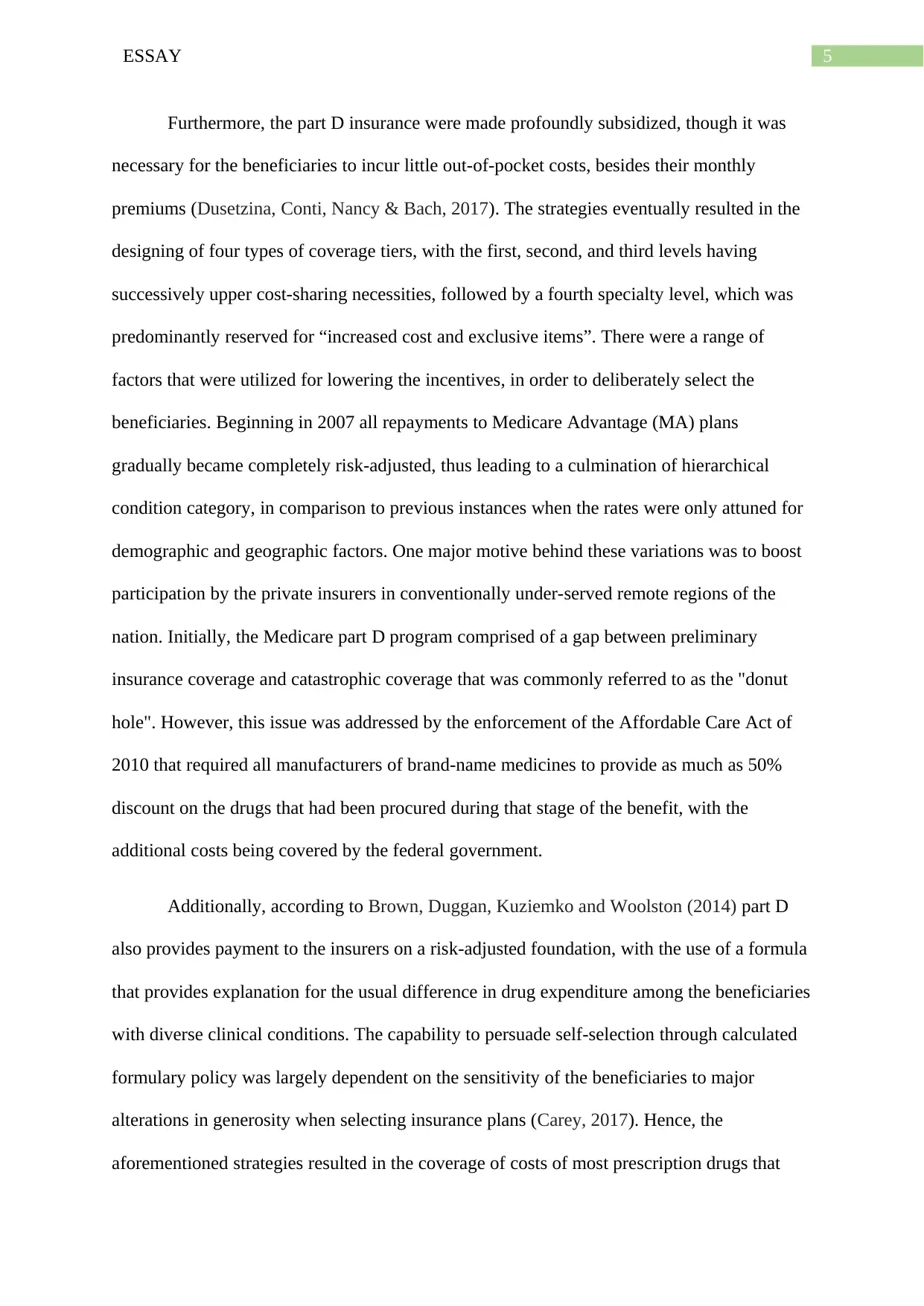
5ESSAY
Furthermore, the part D insurance were made profoundly subsidized, though it was
necessary for the beneficiaries to incur little out-of-pocket costs, besides their monthly
premiums (Dusetzina, Conti, Nancy & Bach, 2017). The strategies eventually resulted in the
designing of four types of coverage tiers, with the first, second, and third levels having
successively upper cost-sharing necessities, followed by a fourth specialty level, which was
predominantly reserved for “increased cost and exclusive items”. There were a range of
factors that were utilized for lowering the incentives, in order to deliberately select the
beneficiaries. Beginning in 2007 all repayments to Medicare Advantage (MA) plans
gradually became completely risk-adjusted, thus leading to a culmination of hierarchical
condition category, in comparison to previous instances when the rates were only attuned for
demographic and geographic factors. One major motive behind these variations was to boost
participation by the private insurers in conventionally under-served remote regions of the
nation. Initially, the Medicare part D program comprised of a gap between preliminary
insurance coverage and catastrophic coverage that was commonly referred to as the "donut
hole". However, this issue was addressed by the enforcement of the Affordable Care Act of
2010 that required all manufacturers of brand-name medicines to provide as much as 50%
discount on the drugs that had been procured during that stage of the benefit, with the
additional costs being covered by the federal government.
Additionally, according to Brown, Duggan, Kuziemko and Woolston (2014) part D
also provides payment to the insurers on a risk-adjusted foundation, with the use of a formula
that provides explanation for the usual difference in drug expenditure among the beneficiaries
with diverse clinical conditions. The capability to persuade self-selection through calculated
formulary policy was largely dependent on the sensitivity of the beneficiaries to major
alterations in generosity when selecting insurance plans (Carey, 2017). Hence, the
aforementioned strategies resulted in the coverage of costs of most prescription drugs that
Furthermore, the part D insurance were made profoundly subsidized, though it was
necessary for the beneficiaries to incur little out-of-pocket costs, besides their monthly
premiums (Dusetzina, Conti, Nancy & Bach, 2017). The strategies eventually resulted in the
designing of four types of coverage tiers, with the first, second, and third levels having
successively upper cost-sharing necessities, followed by a fourth specialty level, which was
predominantly reserved for “increased cost and exclusive items”. There were a range of
factors that were utilized for lowering the incentives, in order to deliberately select the
beneficiaries. Beginning in 2007 all repayments to Medicare Advantage (MA) plans
gradually became completely risk-adjusted, thus leading to a culmination of hierarchical
condition category, in comparison to previous instances when the rates were only attuned for
demographic and geographic factors. One major motive behind these variations was to boost
participation by the private insurers in conventionally under-served remote regions of the
nation. Initially, the Medicare part D program comprised of a gap between preliminary
insurance coverage and catastrophic coverage that was commonly referred to as the "donut
hole". However, this issue was addressed by the enforcement of the Affordable Care Act of
2010 that required all manufacturers of brand-name medicines to provide as much as 50%
discount on the drugs that had been procured during that stage of the benefit, with the
additional costs being covered by the federal government.
Additionally, according to Brown, Duggan, Kuziemko and Woolston (2014) part D
also provides payment to the insurers on a risk-adjusted foundation, with the use of a formula
that provides explanation for the usual difference in drug expenditure among the beneficiaries
with diverse clinical conditions. The capability to persuade self-selection through calculated
formulary policy was largely dependent on the sensitivity of the beneficiaries to major
alterations in generosity when selecting insurance plans (Carey, 2017). Hence, the
aforementioned strategies resulted in the coverage of costs of most prescription drugs that
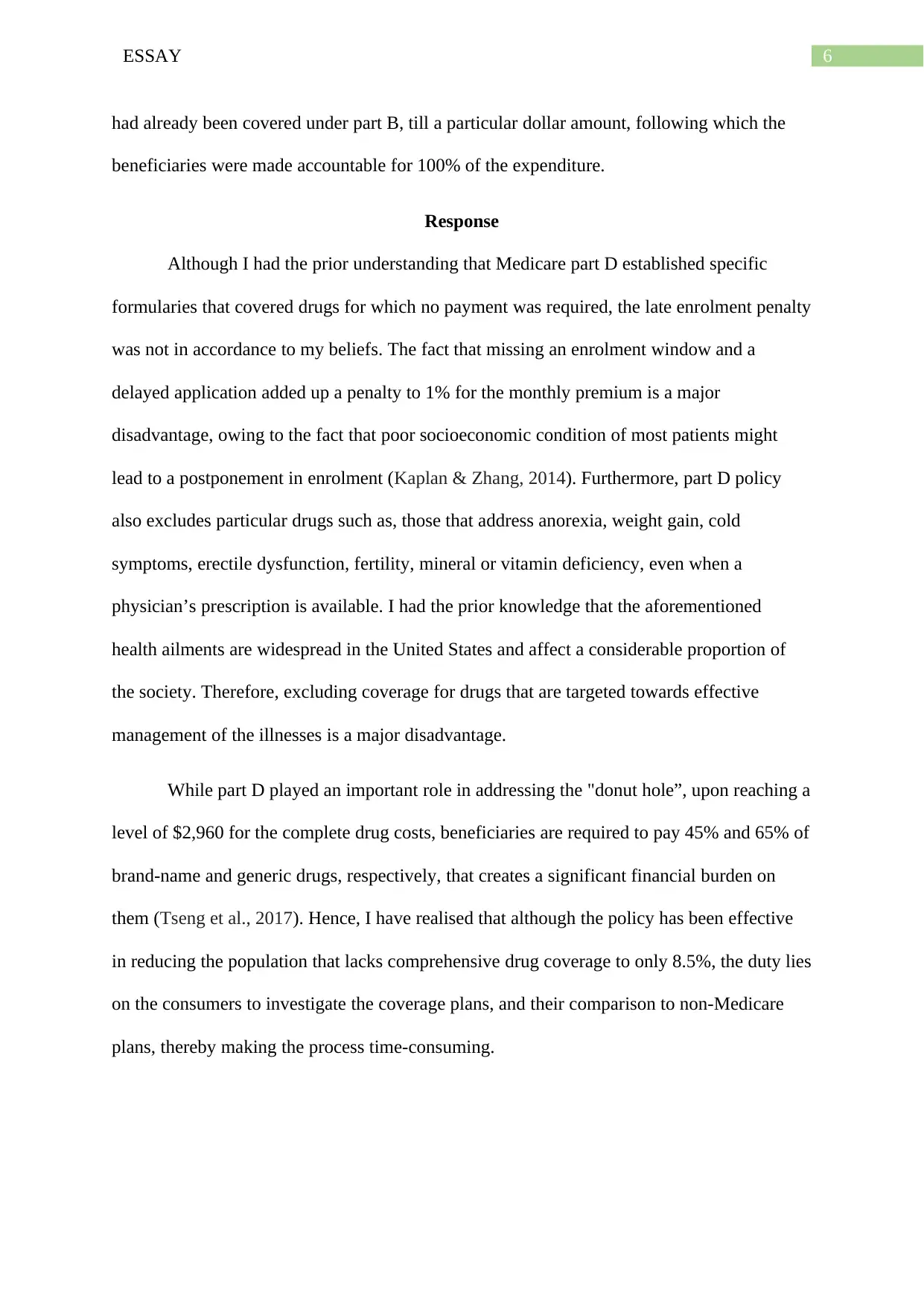
6ESSAY
had already been covered under part B, till a particular dollar amount, following which the
beneficiaries were made accountable for 100% of the expenditure.
Response
Although I had the prior understanding that Medicare part D established specific
formularies that covered drugs for which no payment was required, the late enrolment penalty
was not in accordance to my beliefs. The fact that missing an enrolment window and a
delayed application added up a penalty to 1% for the monthly premium is a major
disadvantage, owing to the fact that poor socioeconomic condition of most patients might
lead to a postponement in enrolment (Kaplan & Zhang, 2014). Furthermore, part D policy
also excludes particular drugs such as, those that address anorexia, weight gain, cold
symptoms, erectile dysfunction, fertility, mineral or vitamin deficiency, even when a
physician’s prescription is available. I had the prior knowledge that the aforementioned
health ailments are widespread in the United States and affect a considerable proportion of
the society. Therefore, excluding coverage for drugs that are targeted towards effective
management of the illnesses is a major disadvantage.
While part D played an important role in addressing the "donut hole”, upon reaching a
level of $2,960 for the complete drug costs, beneficiaries are required to pay 45% and 65% of
brand-name and generic drugs, respectively, that creates a significant financial burden on
them (Tseng et al., 2017). Hence, I have realised that although the policy has been effective
in reducing the population that lacks comprehensive drug coverage to only 8.5%, the duty lies
on the consumers to investigate the coverage plans, and their comparison to non-Medicare
plans, thereby making the process time-consuming.
had already been covered under part B, till a particular dollar amount, following which the
beneficiaries were made accountable for 100% of the expenditure.
Response
Although I had the prior understanding that Medicare part D established specific
formularies that covered drugs for which no payment was required, the late enrolment penalty
was not in accordance to my beliefs. The fact that missing an enrolment window and a
delayed application added up a penalty to 1% for the monthly premium is a major
disadvantage, owing to the fact that poor socioeconomic condition of most patients might
lead to a postponement in enrolment (Kaplan & Zhang, 2014). Furthermore, part D policy
also excludes particular drugs such as, those that address anorexia, weight gain, cold
symptoms, erectile dysfunction, fertility, mineral or vitamin deficiency, even when a
physician’s prescription is available. I had the prior knowledge that the aforementioned
health ailments are widespread in the United States and affect a considerable proportion of
the society. Therefore, excluding coverage for drugs that are targeted towards effective
management of the illnesses is a major disadvantage.
While part D played an important role in addressing the "donut hole”, upon reaching a
level of $2,960 for the complete drug costs, beneficiaries are required to pay 45% and 65% of
brand-name and generic drugs, respectively, that creates a significant financial burden on
them (Tseng et al., 2017). Hence, I have realised that although the policy has been effective
in reducing the population that lacks comprehensive drug coverage to only 8.5%, the duty lies
on the consumers to investigate the coverage plans, and their comparison to non-Medicare
plans, thereby making the process time-consuming.
Paraphrase This Document
Need a fresh take? Get an instant paraphrase of this document with our AI Paraphraser

7ESSAY
Conclusion
To conclude, Medicare part D refers to the federal program that has been created with
the sole objective of offering Medicare recipients the occasion to get prescription drug
coverage. It typically comprises of deductibles, premiums, and co-payments. Nonetheless,
reimbursing for prescription drugs can be tremendously costly without any drug coverage.
While the standalone part D prescription drug policies are directed towards a joint
implementation with part A and B coverage, it is essential to increase the awareness among
the beneficiaries about the potential expenditures that they would incur if they fail to sign up
for the coverage plans.
Conclusion
To conclude, Medicare part D refers to the federal program that has been created with
the sole objective of offering Medicare recipients the occasion to get prescription drug
coverage. It typically comprises of deductibles, premiums, and co-payments. Nonetheless,
reimbursing for prescription drugs can be tremendously costly without any drug coverage.
While the standalone part D prescription drug policies are directed towards a joint
implementation with part A and B coverage, it is essential to increase the awareness among
the beneficiaries about the potential expenditures that they would incur if they fail to sign up
for the coverage plans.
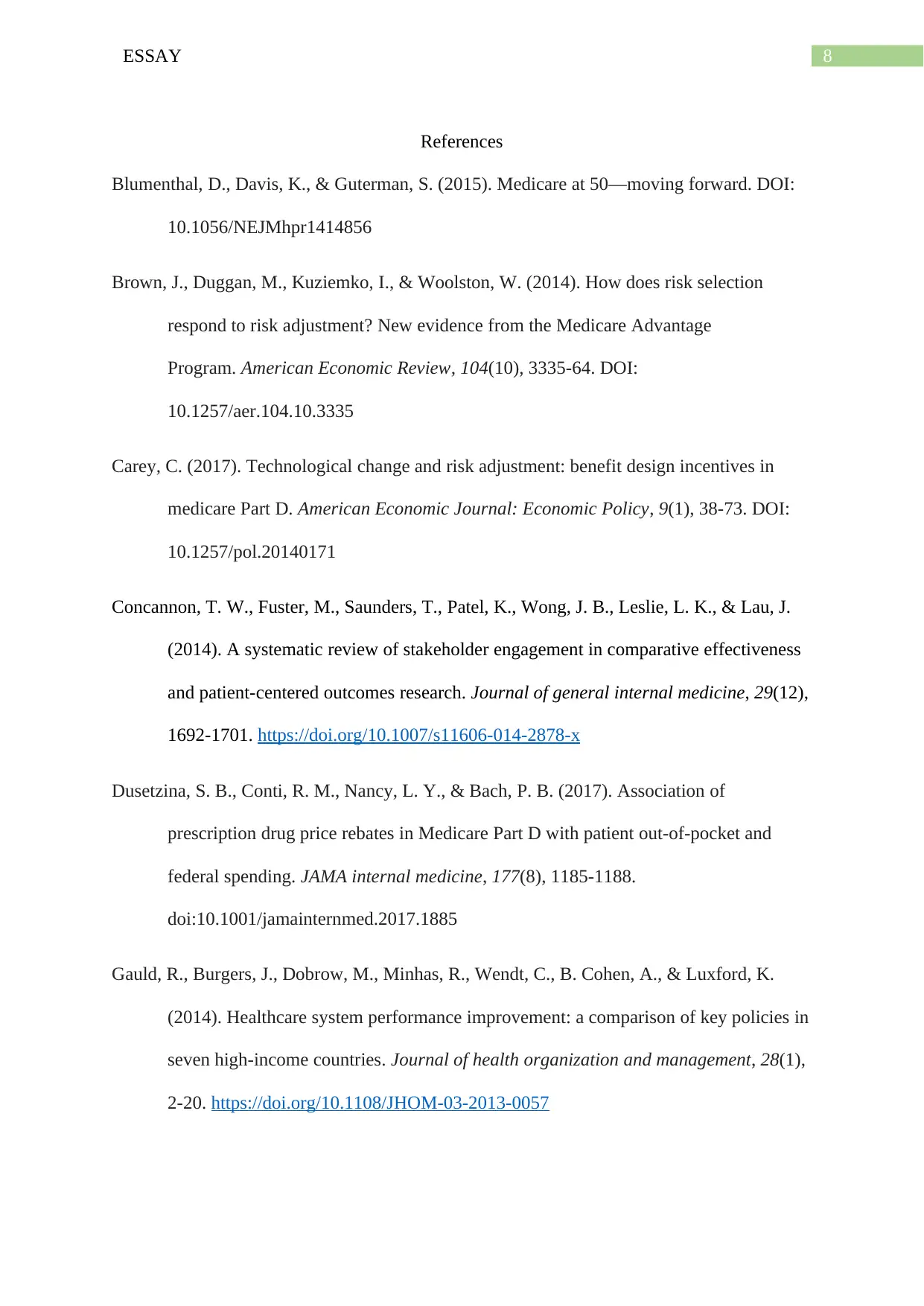
8ESSAY
References
Blumenthal, D., Davis, K., & Guterman, S. (2015). Medicare at 50—moving forward. DOI:
10.1056/NEJMhpr1414856
Brown, J., Duggan, M., Kuziemko, I., & Woolston, W. (2014). How does risk selection
respond to risk adjustment? New evidence from the Medicare Advantage
Program. American Economic Review, 104(10), 3335-64. DOI:
10.1257/aer.104.10.3335
Carey, C. (2017). Technological change and risk adjustment: benefit design incentives in
medicare Part D. American Economic Journal: Economic Policy, 9(1), 38-73. DOI:
10.1257/pol.20140171
Concannon, T. W., Fuster, M., Saunders, T., Patel, K., Wong, J. B., Leslie, L. K., & Lau, J.
(2014). A systematic review of stakeholder engagement in comparative effectiveness
and patient-centered outcomes research. Journal of general internal medicine, 29(12),
1692-1701. https://doi.org/10.1007/s11606-014-2878-x
Dusetzina, S. B., Conti, R. M., Nancy, L. Y., & Bach, P. B. (2017). Association of
prescription drug price rebates in Medicare Part D with patient out-of-pocket and
federal spending. JAMA internal medicine, 177(8), 1185-1188.
doi:10.1001/jamainternmed.2017.1885
Gauld, R., Burgers, J., Dobrow, M., Minhas, R., Wendt, C., B. Cohen, A., & Luxford, K.
(2014). Healthcare system performance improvement: a comparison of key policies in
seven high-income countries. Journal of health organization and management, 28(1),
2-20. https://doi.org/10.1108/JHOM-03-2013-0057
References
Blumenthal, D., Davis, K., & Guterman, S. (2015). Medicare at 50—moving forward. DOI:
10.1056/NEJMhpr1414856
Brown, J., Duggan, M., Kuziemko, I., & Woolston, W. (2014). How does risk selection
respond to risk adjustment? New evidence from the Medicare Advantage
Program. American Economic Review, 104(10), 3335-64. DOI:
10.1257/aer.104.10.3335
Carey, C. (2017). Technological change and risk adjustment: benefit design incentives in
medicare Part D. American Economic Journal: Economic Policy, 9(1), 38-73. DOI:
10.1257/pol.20140171
Concannon, T. W., Fuster, M., Saunders, T., Patel, K., Wong, J. B., Leslie, L. K., & Lau, J.
(2014). A systematic review of stakeholder engagement in comparative effectiveness
and patient-centered outcomes research. Journal of general internal medicine, 29(12),
1692-1701. https://doi.org/10.1007/s11606-014-2878-x
Dusetzina, S. B., Conti, R. M., Nancy, L. Y., & Bach, P. B. (2017). Association of
prescription drug price rebates in Medicare Part D with patient out-of-pocket and
federal spending. JAMA internal medicine, 177(8), 1185-1188.
doi:10.1001/jamainternmed.2017.1885
Gauld, R., Burgers, J., Dobrow, M., Minhas, R., Wendt, C., B. Cohen, A., & Luxford, K.
(2014). Healthcare system performance improvement: a comparison of key policies in
seven high-income countries. Journal of health organization and management, 28(1),
2-20. https://doi.org/10.1108/JHOM-03-2013-0057
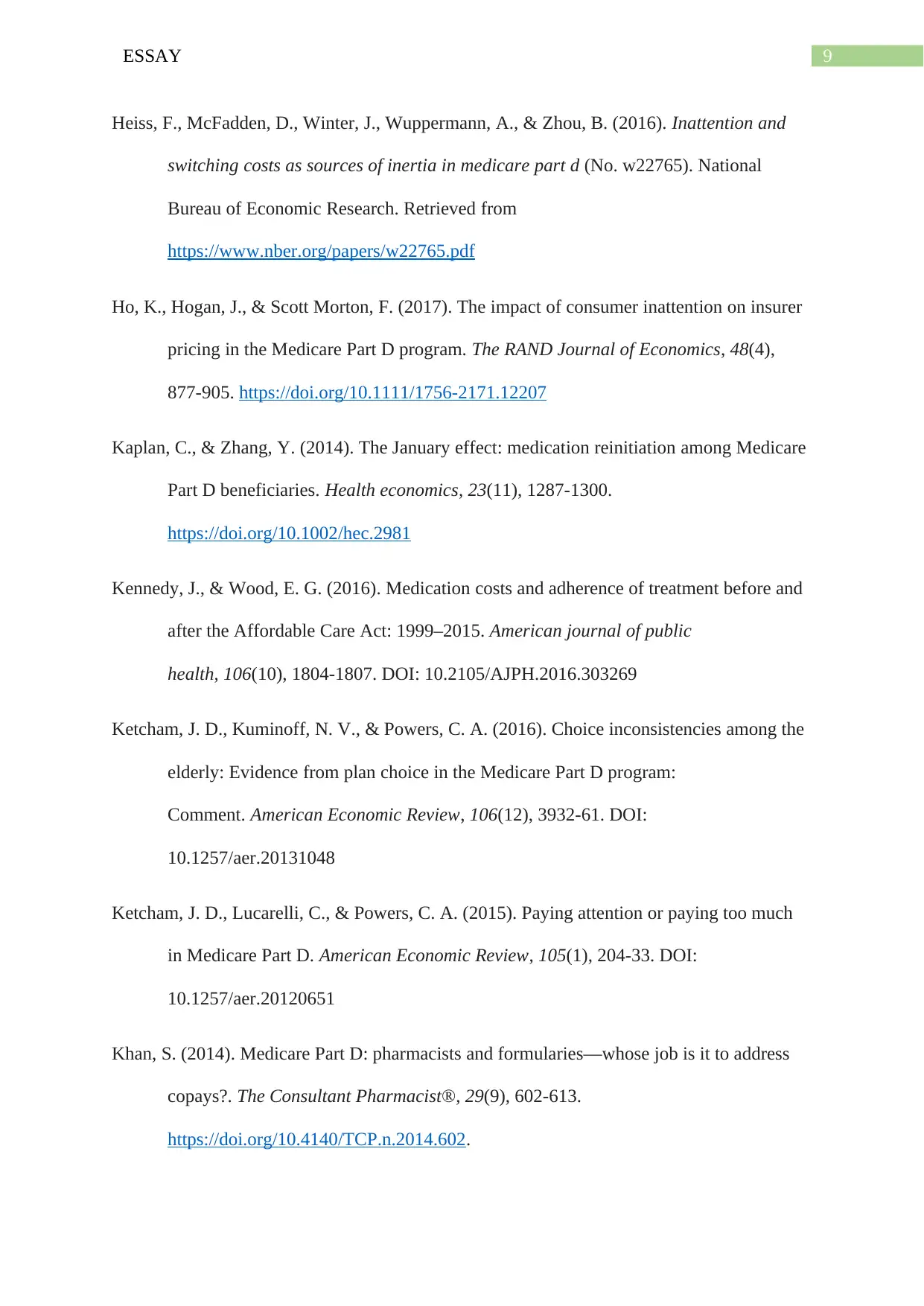
9ESSAY
Heiss, F., McFadden, D., Winter, J., Wuppermann, A., & Zhou, B. (2016). Inattention and
switching costs as sources of inertia in medicare part d (No. w22765). National
Bureau of Economic Research. Retrieved from
https://www.nber.org/papers/w22765.pdf
Ho, K., Hogan, J., & Scott Morton, F. (2017). The impact of consumer inattention on insurer
pricing in the Medicare Part D program. The RAND Journal of Economics, 48(4),
877-905. https://doi.org/10.1111/1756-2171.12207
Kaplan, C., & Zhang, Y. (2014). The January effect: medication reinitiation among Medicare
Part D beneficiaries. Health economics, 23(11), 1287-1300.
https://doi.org/10.1002/hec.2981
Kennedy, J., & Wood, E. G. (2016). Medication costs and adherence of treatment before and
after the Affordable Care Act: 1999–2015. American journal of public
health, 106(10), 1804-1807. DOI: 10.2105/AJPH.2016.303269
Ketcham, J. D., Kuminoff, N. V., & Powers, C. A. (2016). Choice inconsistencies among the
elderly: Evidence from plan choice in the Medicare Part D program:
Comment. American Economic Review, 106(12), 3932-61. DOI:
10.1257/aer.20131048
Ketcham, J. D., Lucarelli, C., & Powers, C. A. (2015). Paying attention or paying too much
in Medicare Part D. American Economic Review, 105(1), 204-33. DOI:
10.1257/aer.20120651
Khan, S. (2014). Medicare Part D: pharmacists and formularies—whose job is it to address
copays?. The Consultant Pharmacist®, 29(9), 602-613.
https://doi.org/10.4140/TCP.n.2014.602.
Heiss, F., McFadden, D., Winter, J., Wuppermann, A., & Zhou, B. (2016). Inattention and
switching costs as sources of inertia in medicare part d (No. w22765). National
Bureau of Economic Research. Retrieved from
https://www.nber.org/papers/w22765.pdf
Ho, K., Hogan, J., & Scott Morton, F. (2017). The impact of consumer inattention on insurer
pricing in the Medicare Part D program. The RAND Journal of Economics, 48(4),
877-905. https://doi.org/10.1111/1756-2171.12207
Kaplan, C., & Zhang, Y. (2014). The January effect: medication reinitiation among Medicare
Part D beneficiaries. Health economics, 23(11), 1287-1300.
https://doi.org/10.1002/hec.2981
Kennedy, J., & Wood, E. G. (2016). Medication costs and adherence of treatment before and
after the Affordable Care Act: 1999–2015. American journal of public
health, 106(10), 1804-1807. DOI: 10.2105/AJPH.2016.303269
Ketcham, J. D., Kuminoff, N. V., & Powers, C. A. (2016). Choice inconsistencies among the
elderly: Evidence from plan choice in the Medicare Part D program:
Comment. American Economic Review, 106(12), 3932-61. DOI:
10.1257/aer.20131048
Ketcham, J. D., Lucarelli, C., & Powers, C. A. (2015). Paying attention or paying too much
in Medicare Part D. American Economic Review, 105(1), 204-33. DOI:
10.1257/aer.20120651
Khan, S. (2014). Medicare Part D: pharmacists and formularies—whose job is it to address
copays?. The Consultant Pharmacist®, 29(9), 602-613.
https://doi.org/10.4140/TCP.n.2014.602.
Secure Best Marks with AI Grader
Need help grading? Try our AI Grader for instant feedback on your assignments.

10ESSAY
Kirchhoff, S. M. (2018). Medicare Part D Prescription Drug Benefit. Retrieved from
https://fas.org/sgp/crs/misc/R40611.pdf
Owen, J. A. (2014). Medicare star ratings: Stakeholder proceedings on community pharmacy
and managed care partnerships in quality: American Pharmacists Association and
Academy of Managed Care Pharmacy. Journal of the American Pharmacists
Association, 54(3), 228-240. https://doi.org/10.1331/JAPhA.2014.13180
Perlis, R. H., & Perlis, C. S. (2016). Physician payments from industry are associated with
greater Medicare Part D prescribing costs. PloS one, 11(5), e0155474.
https://doi.org/10.1371/journal.pone.0155474
Polyakova, M. (2016). Regulation of insurance with adverse selection and switching costs:
Evidence from Medicare Part D. American Economic Journal: Applied
Economics, 8(3), 165-95. DOI: 10.1257/app.20150004
Tseng, C. W., Yazdany, J., Dudley, R. A., DeJong, C., Kazi, D. S., Chen, R., & Lin, G. A.
(2017). Medicare Part D plans’ coverage and cost-sharing for acute rescue and
preventive inhalers for chronic obstructive pulmonary disease. JAMA internal
medicine, 177(4), 585-588. doi:10.1001/jamainternmed.2016.9386
Yazdany, J., Dudley, R. A., Chen, R., Lin, G. A., & Tseng, C. W. (2015). Coverage for high‐
cost specialty drugs for rheumatoid arthritis in Medicare Part D. Arthritis &
Rheumatology, 67(6), 1474-1480. DOI 10.1002/art.39079
Kirchhoff, S. M. (2018). Medicare Part D Prescription Drug Benefit. Retrieved from
https://fas.org/sgp/crs/misc/R40611.pdf
Owen, J. A. (2014). Medicare star ratings: Stakeholder proceedings on community pharmacy
and managed care partnerships in quality: American Pharmacists Association and
Academy of Managed Care Pharmacy. Journal of the American Pharmacists
Association, 54(3), 228-240. https://doi.org/10.1331/JAPhA.2014.13180
Perlis, R. H., & Perlis, C. S. (2016). Physician payments from industry are associated with
greater Medicare Part D prescribing costs. PloS one, 11(5), e0155474.
https://doi.org/10.1371/journal.pone.0155474
Polyakova, M. (2016). Regulation of insurance with adverse selection and switching costs:
Evidence from Medicare Part D. American Economic Journal: Applied
Economics, 8(3), 165-95. DOI: 10.1257/app.20150004
Tseng, C. W., Yazdany, J., Dudley, R. A., DeJong, C., Kazi, D. S., Chen, R., & Lin, G. A.
(2017). Medicare Part D plans’ coverage and cost-sharing for acute rescue and
preventive inhalers for chronic obstructive pulmonary disease. JAMA internal
medicine, 177(4), 585-588. doi:10.1001/jamainternmed.2016.9386
Yazdany, J., Dudley, R. A., Chen, R., Lin, G. A., & Tseng, C. W. (2015). Coverage for high‐
cost specialty drugs for rheumatoid arthritis in Medicare Part D. Arthritis &
Rheumatology, 67(6), 1474-1480. DOI 10.1002/art.39079
1 out of 11
Related Documents
Your All-in-One AI-Powered Toolkit for Academic Success.
+13062052269
info@desklib.com
Available 24*7 on WhatsApp / Email
![[object Object]](/_next/static/media/star-bottom.7253800d.svg)
Unlock your academic potential
© 2024 | Zucol Services PVT LTD | All rights reserved.





